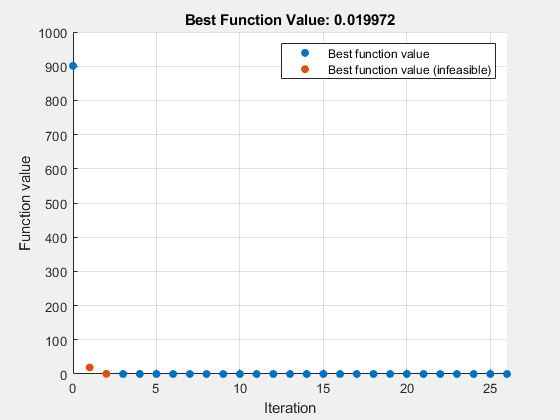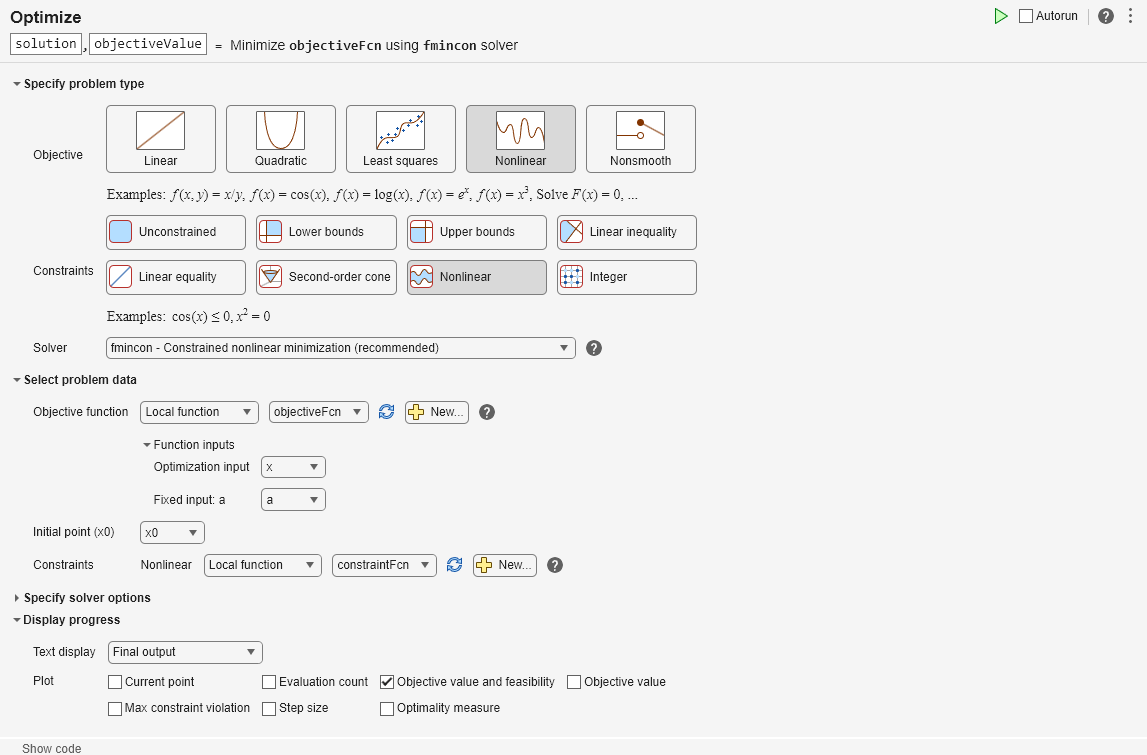ソルバーベースの最適化ライブ エディター タスクの概要
このサンプル スクリプトは、ソルバーベースの "最適化" ライブ エディター タスクを使用した最適化や方程式解法を示しています。独自の問題に合わせてスクリプトを修正してください。
このスクリプトは、非線形制約を伴う非線形最適化問題を解きます。
パラメーターまたはデータの挿入
通常は、データや値をソルバーに渡します。これらの値を入力セクション (x0 が表示されている) に入力し、[セクション]、[セクションの実行] を選択するか、Control+Enter を押すことによってセクションを実行します。
初期点 x0 を設定し、最適化するために a をスケールします。
x0 = [2;1]; a = 100;
先に進む前にこのセクションを実行することによって、x0 の値と他の問題データをワークスペースに配置します。
最適化ライブ エディター タスク
通常は、[ライブ エディター] タブで [タスク] > [最適化] を選択するか、または [挿入] タブで [タスク] > [最適化] を選択して、最適化ライブ エディター タスクをスクリプトに配置します。このとき、次の選択肢が表示されます。(これは単なるイメージで、実際のタスクではありません。)

ソルバーベースのタスクを選択するには、[ソルバーベース] をクリックします。
次のソルバーベースのタスクには、目的関数と非線形制約関数が含まれています。これらの関数を変更するには、タスクの下の関数リストを編集します。
制約を変更するには、該当する制約タイプを選択して、入力ボックスに値を入力します。上記の x0 が含まれるセクションに値を入力して、そのセクションを実行し、ワークスペースに値を配置しなければならない場合があります。
左側の縞模様のバーをクリックする、[実行] または [セクション]、[セクションの実行] を選択する、あるいは Control+Enter を押すことによって、タスクを実行します。

Local minimum found that satisfies the constraints. Optimization completed because the objective function is non-decreasing in feasible directions, to within the value of the optimality tolerance, and constraints are satisfied to within the value of the constraint tolerance. <stopping criteria details>
結果
Optimize は、解をワークスペース変数 solution に保存し、その解での目的関数値をワークスペース変数 objectiveValue に保存します。Optimize タスクの一番上でこれらの変数名を表示して変更できます。
これらの変数を表示します。
solution
solution = 2×1
1.1413
1.3029
objectiveValue
objectiveValue = 0.0200
解での非線形制約関数値を表示します。
[ccons,ceqcons] = constraintFcn(solution)
ccons = 1×2
-2.0000 -0.0000
ceqcons =
[]
補助関数 - ローカル関数
次のコードは目的関数を作成します。独自の問題に合わせてこのコードを修正してください。
function f = objectiveFcn(x,a) f = a*(x(2) - x(1)^2)^2 + (1 - x(1))^2; end
次のコードは制約関数を作成します。独自の問題に合わせてこのコードを修正してください。
function [c,ceq] = constraintFcn(x) c(1) = x(1)^2 + x(2)^2 - 5; c(2) = 3 - x(1)^2 - x(2)^2; ceq = []; % No equality constraints end
